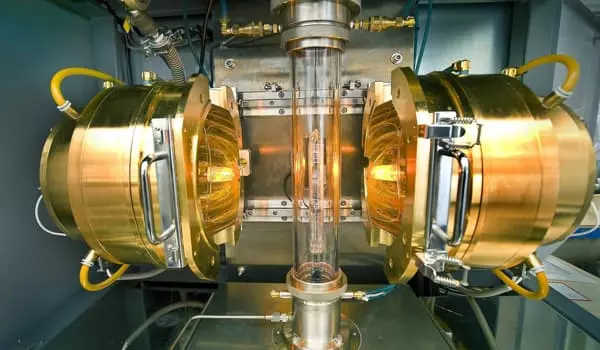An international team has demonstrated superconducting coupling between two regions separated by a one micron wide ferromagnetic compound. The Josephson effect, a macroscopic quantum effect, generates an electrical current within the ferromagnetic compound made of superconducting Cooper-pairs. Magnetic imaging of the ferromagnetic region at BESSY II helped to show that the spins of the electrons forming the Cooper pairs are equal. These findings pave the way for low-power superconducting spintronic applications in which spin-polarized currents can be protected by quantum coherence.
A special quantum effect can occur when two superconducting regions are separated by a strip of non-superconducting material, coupling both regions: It’s called the Josephson effect. If the spacer material is a half-metal ferromagnet, it opens up new possibilities for spintronic applications. For the first time, an international team has created a material system that exhibits an unusually long-range Josephson effect: A one-micron-wide region of half-metallic, ferromagnetic manganite (La2/3Sr1/3MnO3) separates superconducting YBa2Cu3O7 regions.
The researchers were able to demonstrate the presence of a supercurrent circulating through the manganite using magneto-transport measurements; this supercurrent is arising from the superconducting coupling between both superconducting regions, and thus a manifestation of a Josephson effect with a macroscopic long range.
We mapped and measured the magnetic domains within the manganite spacer at BESSY II’s XMCD-PEEM station. We discovered large areas that were homogeneously magnetized and connected the superconducting regions. Triplet spin pairs can freely propagate in these.
Dr. Sergio Valencia Molina.
Extremely rare: Triplett superconductivity
In addition, the researchers investigated another intriguing property that has far-reaching implications for spintronic applications. In superconductors, electrons form so-called Cooper pairs. In the vast majority of superconducting materials, these pairs are composed of electrons with opposite spin to reduce the magnetic exchange field, which is detrimental to superconductivity stability. The ferromagnet used by the international team was a half-ferromagnet, which allows only one spin type electron to circulate. The detection of a supercurrent within this material implies that the Cooper pairs of this supercurrent must be composed of electrons with the same spin. This type of superconductivity, known as “triplet superconductivity,” is extremely rare.

Magnetism and superconductivity are normally mutually antagonistic material properties, but combining them in a nanostructure results in unexpected effects found in neither system. Researchers from the University of Jyväskylä and the University of San Sebastian have now reviewed the theory of electron transport in superconductors near magnetic material. They specifically demonstrate how to describe the coupled transport of spin, charge, and energy in such systems. This theory’s understanding enables the development and optimization of new functionalities for these systems, such as thermoelectric detectors. The findings were published in the journal Progress in Surface Science.
Mapping magnetic domains at BESSY II
“We mapped and measured the magnetic domains within the manganite spacer at BESSY II’s XMCD-PEEM station. We discovered large areas that were homogeneously magnetized and connected the superconducting regions. Triplet spin pairs can freely propagate in these “Dr. Sergio Valencia Molina, HZB physicist who oversaw the measurements at BESSY II, explains.
Because superconducting currents flow without resistance, they are ideal for low-power consumption applications. This current is made up of electrons with equal spins in this case. Such spin polarised currents could be used in novel superconducting spintronic applications for information transport (over long distances) and reading/writing while benefiting from the stability imposed by the Josephson effect’s macroscopic quantum coherence.
As a result, the new device made of superconducting and ferromagnetic components opens up new opportunities for superconducting spintronics as well as new perspectives for quantum computing.
Many research groups have recently focused on developing magnetic memories, which are based on writing and reading magnetic information using an electric current. Such systems typically necessitate such high currents to switch the magnetization that the thermal stability of the memory element is jeopardized. Superconducting materials that can sustain dissipationless electric current would be very useful for reducing heating effects. The international research team, which included researchers from the University of Jyväskylä, demonstrated that domain wall motion can be detected by monitoring voltage generated in superconducting devices. This discovery may pave the way for magnetic racetrack memory applications.














